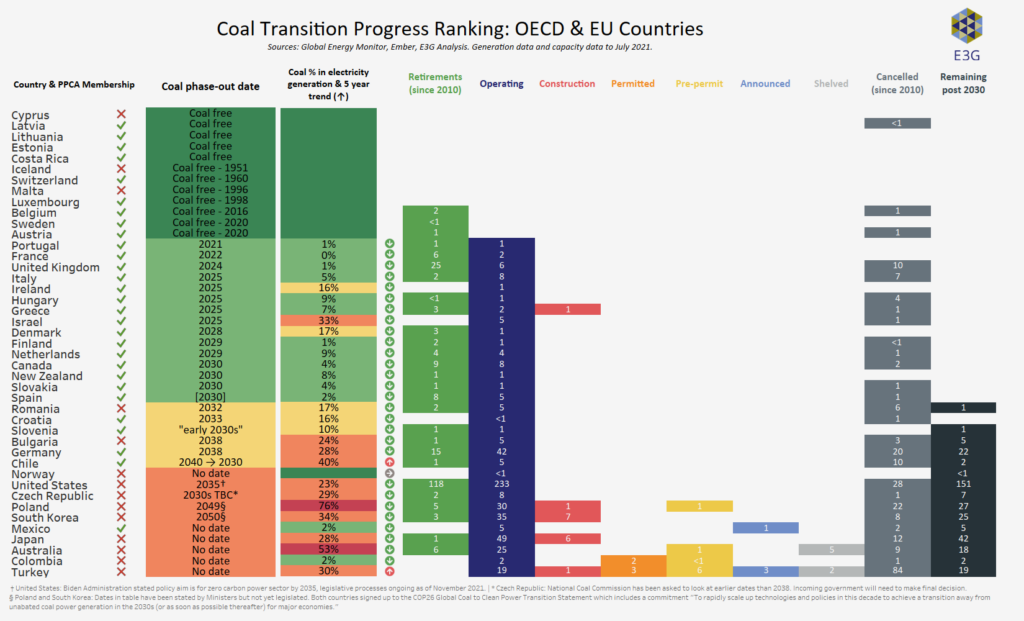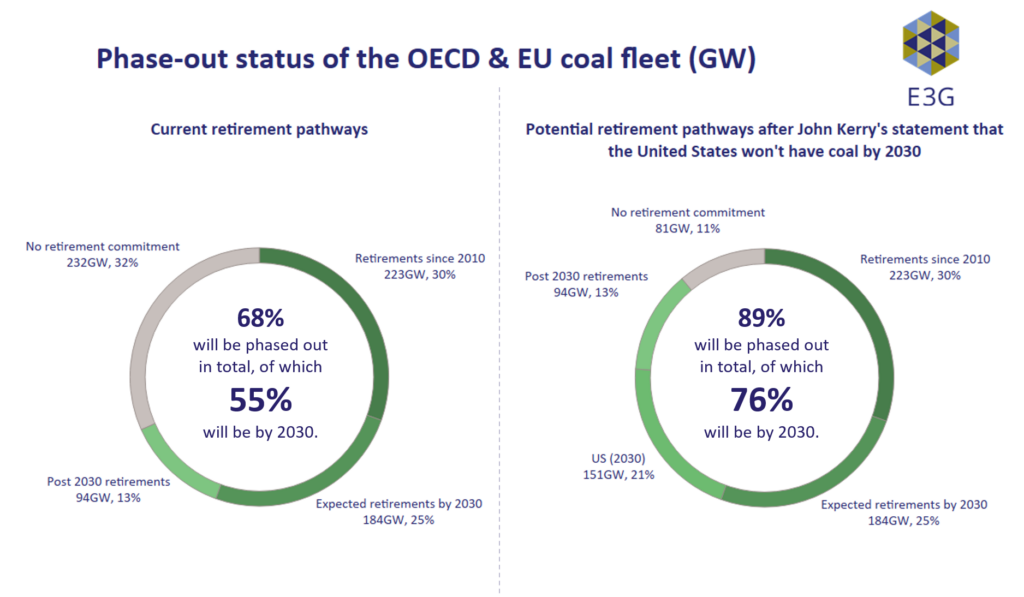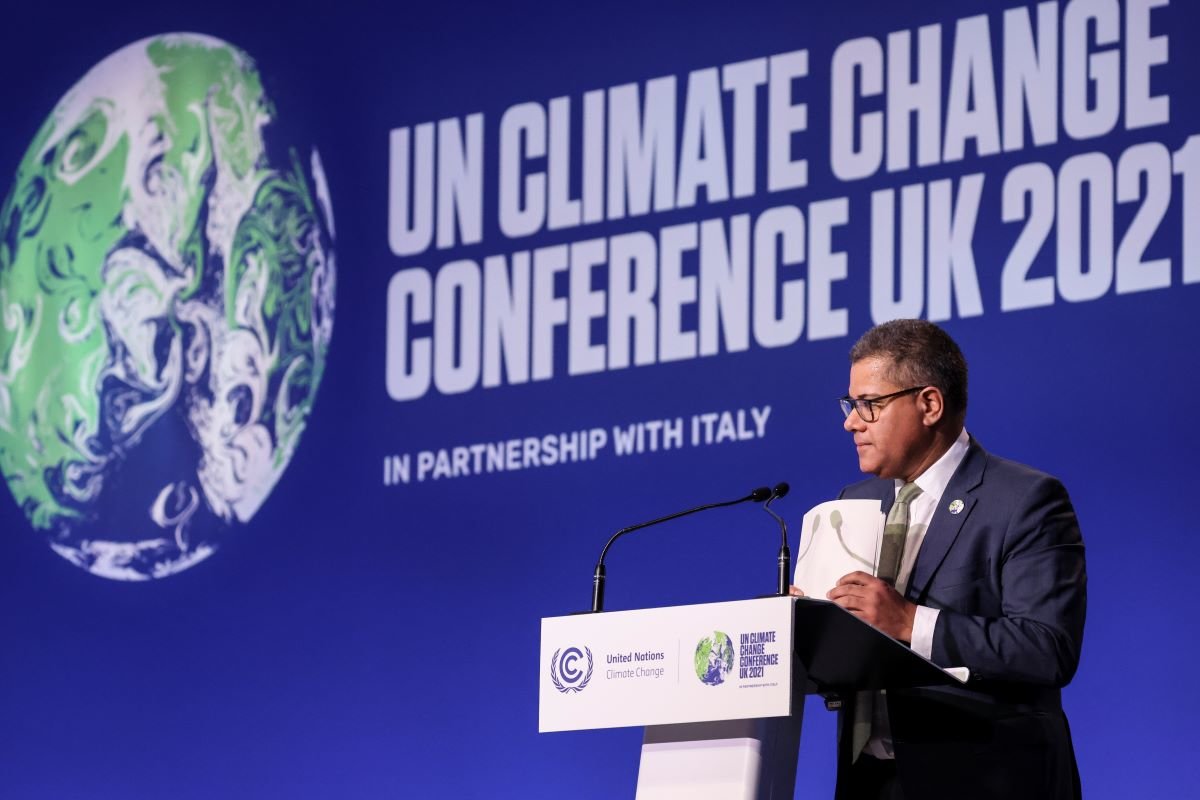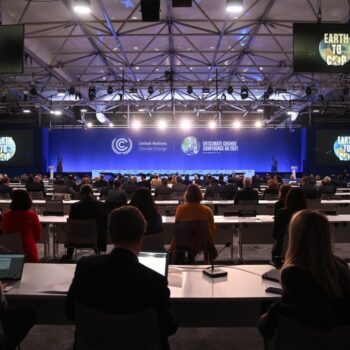Pre-COP Status: 🟢 COP26 Progress: 🟠 Post-COP Momentum: 🟢
Multiple major coal countries reflect global trends with new commitments to phase out existing coal power through the Global Coal to Clean Power Transition Statement and membership of the Powering Past Coal Alliance (PPCA). Notable commitments were made by Viet Nam, Indonesia, Poland, South Korea, Ukraine, and the EU. Domestic implementation and international pressure are necessary to translate pledges into reality. Momentum away from coal increases pressure on laggards.
The COP that consigns coal to history
Existing coal power generation is the biggest contributor to global temperature increases. Though coal phase out is not included in the official UNFCCC negotiations, COP President Alok Sharma and UK PM Boris Johnson had called for Glasgow to “consign coal to history”.
The Global Coal to Clean Power Transition Statement was the vehicle for encouraging countries to make commitments, including “to achieve a transition away from unabated coal power generation in the 2030s (or as soon as possible thereafter) for major economies and in the 2040s (or as soon as possible thereafter) globally.” This approach intentionally lowered the threshold for committing to coal phase out compared to the stricter membership criteria required by PPCA, to initiate progress from a new tranche of countries. PPCA experience showed that once started on the coal exit pathway, countries invariably accelerated towards phase out.
Global progress on phasing out existing coal power, but pledges need real-world activation
The UK strategy secured signals on coal phase out from three of the world’s top 10 coal users: South Korea, Indonesia, and Viet Nam. Europe’s second and third largest coal users, Poland and Ukraine, also stepped up.
To align with the pledge’s timeframe, South Korea (the world’s 5th biggest coal user) and Poland (Europe’s second-largest) are now under pressure to accelerate phase-outs into the 2030s, or as soon as possible thereafter. Both subsequently sought to redefine their participation on their own terms, however. The South Korean Industry Ministry dampened 2030s phase out expectations by saying they never agreed on a phase-out timeline, just efforts to reduce coal. Indeed, President Moon had indicated a 2050 coal phase out earlier at COP, arousing strong civil society push back. Similarly, Poland unusually declared it was not a major economy, and that its 2049 coal mining phase out date still stood. This flip-flopping shows that phasing out existing coal power is a live topic within these governments. They recognise the need for a faster phase out but are uncertain of the political strategy to deliver it. Later dates, however, are not credible. A 2030s timeframe is both achievable and necessary.
Viet Nam (9th largest coal user, with 3rd largest pipeline of proposed new projects) was a major sign-up, following its recent net zero 2050 commitment. It now needs to ensure its draft Power Development Plan reflects the 2040s coal exit pledge. Indonesia (7th largest coal user, largest exporter of coal) also signed, though its 2040s coal phase out is conditional on international assistance.
These countries would be classed as ‘difficult’. Their sign-up is a notable indicator of recent progress in the coal exit agenda.
Beyond the biggest countries, all continents were represented: Chile and Ecuador in Latin America; Egypt, Zambia and Botswana in Africa; Singapore, Sri Lanka and the Philippines in Asia (albeit the latter with caveats); New Zealand; Canada; Albania and a raft of EU member states. Crucially, EU Energy Commissioner Kadri Simson signed the bloc up. The first formal expression of EU ambition for a 2030s coal phase out reflects EU Member State trends, and sends a clear signal to Poland.
Additionally, seven countries joined the Powering Past Coal Alliance (PPCA) at COP26, which requires a phase out commitment. New signatories included Chile, Ukraine, and Singapore, the first Asian country to join. Chile pledged steps to bring forward its current 2040 phase-out date. The PPCA now covers 43 OECD countries (67%) and 48 countries globally (25%). The table below shows the growing list of OECD and EU countries with clear phase-out dates, leaving ever-fewer countries uncommitted.

The operational coal capacity of PPCA members and signatories to the Statement totals 268GW. This is more than the coal fleet of the US or India and second only to China. Despite some evident non-signers, the trajectory of international political decision-making on phasing out existing coal power is now catching up with the real-world economics of the energy transition.
E3G calculates that 55% of OECD and EU coal has either retired since 2010 or is scheduled to close by 2030. Factoring in post-2030 phase outs takes this to 68% of capacity heading for retirement. Continued legislative battles on Capitol Hill meant the US did not sign up to the Coal-to-Clean Statement. However, in an interview at COP, US Special Envoy John Kerry predicted that the US would not have coal plants by 2030. Adding the US into the phase out picture would put the OECD firmly on track for a 2030 phase out, with 76% of capacity heading for closure and 89% under some kind of retirement commitment. The minority of countries without a phase out commitment continues to shrink, with Australia seemingly intent on holding out until the bitter end.

What needs to happen next?
- The UK Presidency’s focus on phasing out existing coal power and its efforts to aggregate outcomes sets a new COP benchmark. Coal phase out needs to remain central to climate discussions as a forcing mechanism to engage reluctant countries.
- With a full year of COP Presidency , the UK can continue to focus on coal and push to keep OECD and EU countries on track for 2030 phase out, as pathfinders for others.
- IEA analysis has identified the need for accelerated coal phase out efforts, with all the least efficient sub-critical coal power plants retired by around 2030. This requires a new international effort to build on OECD progress and capitalise on new instruments and finance for coal retirement.



